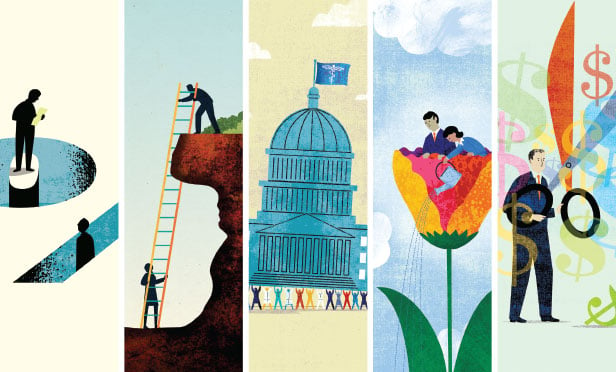 As we close out 2022 and look ahead to 2023, there are a number of trends and milestones in the legislative and regulatory arena that have the potential to impact health care costs for employers and employees alike. Without a crystal ball, it's impossible to say exactly what's to come, but we do have a very good idea of a few things that we should be keeping an eye on.
As we close out 2022 and look ahead to 2023, there are a number of trends and milestones in the legislative and regulatory arena that have the potential to impact health care costs for employers and employees alike. Without a crystal ball, it's impossible to say exactly what's to come, but we do have a very good idea of a few things that we should be keeping an eye on.
Rate increases will continue across the board
Some experts predict a 10% increase in overall health benefits costs, but that isn't the whole story. Factors like labor costs, Rx, and supply chain issues also have major implications for the 2023 overall health care spend.
Mental health will (again) rise to the top in 2023
Over the past decade, the use of mental health services by the workforce has skyrocketed. With the continuing impacts of COVID and legislation that has required more transparency and tighter regulations, people have both greater access to, and awareness about the importance of, mental health. But finding practitioners for mental health services continues to be an issue, with extended wait times on appointments and rising Rx costs.
Recommended For You
The Family Glitch fix will impact group health plans. But will the long term impact be positive or negative?
In October, the Treasury and the IRS issued final updates amending the Affordable Care Act (ACA) regulations that determine affordability for an employee's family members with regard to employer sponsored health care. These changes are effective beginning with the 2023 tax year and are intended to fix a situation known as the Family Glitch.
Under existing regulations from 2012, the affordability of employer-sponsored coverage for a family member was determined by the affordability of self-only coverage. Depending on how an employer subsidized the cost of family coverage, it was possible that coverage could be considered affordable for the employee, but not for family members. Yet those family members would not be eligible for subsidized coverage on the exchange.
With these amended regulations, family members would potentially be eligible for a premium tax credit in the marketplace, but the employee would not. When families applied for 2023 coverage during the open enrollment period in the fall of 2022, the new rules were used to determine whether anyone in the household qualified for a premium subsidy. Will this lead to more employees with families seeking coverage from the marketplace? That remains to be seen.
Will the insurance industry develop new cost-saving ideas?
While health care is a tightly regulated industry, there is still room for innovation in health insurance and employee benefits. In recent years, we've seen new models emerge for managing costs for both employers and employees.
While similar in function to health insurance, health care sharing ministries (HCSMs) are not actually health insurance providers. These organizations are made up of members who share religious or ethical beliefs and make regular financial contributions which are used to reimburse health care costs for other members. To control spending costs, HCSMs generally require members to be in good health and to agree to a shared statement of belief. The statement of belief may impact what types of procedures and medications are eligible for reimbursement.
Available beginning in 2020, an individual coverage health reimbursement arrangement (ICHRA) allows tax-free reimbursement of individual health insurance for businesses of all sizes. An ICHRA is a formal, group health plan that allows the employer to reimburse employees for health care plans purchased from the marketplace. Once an employee has enrolled in an individual health care plan, they submit their receipts for qualified expenses or premium payments and their employer reimburses them, tax-free. From the employer side, payroll deductions are handled in the same way as employer sponsored group plans.
Another cost-containment strategy is reference-based pricing (RBP), which eliminates the disparity between in-network and out-of-network pricing. Used by some self-insured employers, RBP establishes benchmark pricing for services, usually indexed to Medicare reimbursement rates. Covered employees may see the providers of their choice, with no network requirements, as long as the provider agrees to accept the RBP amounts as payment in full.
Will the Consolidated Appropriations Act have a significant impact?
Some health care-related elements of the Consolidated Appropriations Act (CAA) go into effect at the end of 2022, while other provisions are being postponed until at least 2023. One piece to be aware of moving into 2023 relates to surprise billing reports.
The No Surprises Act puts limits on most surprise medical billing — unexpected and often large out-of-network bills sent directly to patients. The Secretary of Health and Human Services, in consultation with the Federal Trade Commission and U.S. attorney general, is required to conduct an annual study on the effects of the provisions in the Act. Additionally, the General Accounting Office must submit a report to Congress on the impact of surprise billing provisions and a report on adequacy of provider networks.
Additionally, there are some big questions for 2023 that can't be answered right now, but that have the potential to dramatically impact the health care landscape:
• Will the COVID pandemic continue to be a factor in 2023? There are so many unknowns, from further mutations of the virus and breakthrough treatments on the medical side, to questions about how vaccines and testing will be covered without further government spending.
• Will Congress pass legislation that changes the ACA? The results of the midterm elections have the potential to change control of both the House and Senate, as well as many state legislatures. The specific power dynamics will determine both state and national legislative priorities and actions.
• Walgreens is now the majority owner of a primary health care company; Walmart acquired a telehealth company to expand into virtual services; and Amazon has acquired a primary care organization, giving it an instant national clinic footprint. What role will mergers and acquisitions have in shaping prices and products in the future?
Misty Baker is the director of compliance and government affairs at BenefitMall & Legislative Committee Chair, NAHU.
© 2025 ALM Global, LLC, All Rights Reserved. Request academic re-use from www.copyright.com. All other uses, submit a request to [email protected]. For more information visit Asset & Logo Licensing.







